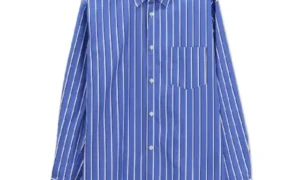The Tartan Kilt, a garment originating from Scotland, has captivated the world with its unique patterns and historical significance. In this article, we will delve into the fascinating story of the Tartan Kilt, exploring its origins, evolution, and current status!
What are tartan kilts?
Tartan kilts are traditional Scottish garments made from tartan fabric, a unique woven cloth characterized by its distinct patterns and colors. The history of tartan dates back centuries, with each pattern representing specific clans or regions. The kilt itself is a knee-length skirt-like garment, often pleated at the back and secured with a belt or buckles. Originally worn for practicality and protection in the Scottish Highlands, tartan kilts have evolved into symbols of Scottish cultural identity and pride. Today, they are not only cherished in Scotland but also admired worldwide for their charm, historical significance, and enduring appeal. Optimize your style with the iconic tartan kilts – a timeless and fashionable choice for any occasion. Explore our exclusive collection now!
The Origins of the Tartan Kilt
The origins of the Tartan Kilt can be traced back to ancient times in Scotland when Celtic tribes weaved colorful patterns to create fabrics. However, the transition to the iconic kilt occurred in the 16th century when Scottish Highlanders began wearing it as a practical garment. The kilt was well-suited for the rugged terrain and unpredictable weather conditions of the region. Over time, the Tartan Kilt gained popularity and became a symbol of Scottish pride.
The Evolution of Tartan Kilt
The evolution of the tartan kilt is a fascinating journey through time. Originating as a practical garment in Scotland’s rugged landscapes, it transformed into a symbol of rebellion during historical conflicts. Banned in the 18th century, its resurgence as a fashion statement marked a new era. From its roots as a clan identifier to a global trendsetter, the tartan kilt’s evolution showcases its enduring relevance and iconic status in the world of fashion and culture.
What kind of tartan do you wear in Scotland?
In Scotland, the tartan you wear often reflects your heritage or affiliation. Different clans and regions have their distinct tartan patterns, each with its unique colors and designs. Wearing a specific tartan can convey a sense of pride in one’s ancestry. While historical ties and family connections traditionally determine the choice, modern Scots also embrace tartans that resonate with their personal style, allowing for a dynamic blend of tradition and individuality.
Is Hiking Kilt a famous tartan kilt?
The concept of a hiking kilt, although not widely recognized in the traditional tartan sense, holds a unique appeal. Historically, tartan kilts are closely tied to clans, regions, and heritage. Nonetheless, in recent times, the outdoor community and avid hikers have warmly embraced the notion of donning lightweight, functional hiking kilts for enhanced practicality during outdoor pursuits. While these kilts don’t adhere to the traditional tartan structure, they have surged in popularity among those yearning for both comfort and unhindered movement amidst nature’s beauty. Step into the world of modern exploration with a touch of heritage – experience the versatility of the hiking kilt today!
How to Wear a Tartan Kilt
Curious about how to wear a kilt? Wearing a tartan kilt is an art that embraces tradition and style. Follow these steps to don the kilt with confidence and flair:
1. Choosing the Right Kilt
Before wearing a kilt, select one that fits well and complements your style. Consider the tartan pattern and color, reflecting your heritage or personal preference.
2. The Correct Way to Wear
Position the kilt around your waist, ensuring it sits comfortably at your natural waistline. The apron (front panel) should fall at knee-length, while the pleats cascade at the back.
3. Fastening the Kilt
Secure the kilt using kilt pins and buckles. Place the kilt pin on the right side of the apron, adding a touch of sophistication. Tighten the leather straps, making sure the kilt stays in place.
4. Accessorizing the Kilt
Complete the look with appropriate accessories like a sporran, a traditional pouch worn at the front, and a belt to add a finishing touch.
5. Pairing with the Right Attire
Choose complementary attire, such as a tailored jacket, shirt, and traditional socks (kilt hose) that align with the kilt’s colors.
Embrace the timeless charm and elegance of the tartan kilt by wearing it with pride and reverence, honoring the rich traditions it embodies.
What is the Future of Tartan Kilts
The future of tartan kilts combines tradition and innovation. Rooted in Scottish culture, these iconic garments symbolize national pride. Sustainability will impact their evolution, as designers explore eco-friendly materials and methods. Smart textiles may enhance comfort and health monitoring, while 3D printing revolutionizes production. Globalization will introduce fusion trends, making kilts popular beyond Scotland. Yet, the essence of tartan kilts remains ingrained, connecting to Scottish heritage and representing clans with pride. The future promises a dynamic tapestry of culture and style, blending old and new in these fascinating garments.
Where to buy a kilt?
Looking to purchase high-quality kilts? Look no further than Fashion Kilt! When it comes to finding the perfect kilt that combines tradition with modern style, Fashion Kilt is your ultimate destination. With a wide range of designs and styles, Fashion Kilt offers a diverse selection that caters to various tastes and occasions. Whether you’re seeking a classic tartan kilt or a contemporary twist on this timeless garment, Fashion Kilt ensures premium craftsmanship and top-notch materials. Explore their collection today and embrace the elegance and heritage that kilts bring to your wardrobe.
FAQs
Is tartan only worn by Scottish people?
While tartan has its origins in Scotland, it has gained popularity globally and is now worn by people from various cultures and backgrounds.
Can I wear a tartan kilt casually, or is it reserved for special occasions?
Tartan kilts can be worn both casually and for special events, making them versatile pieces in one’s wardrobe.
How do I find out which tartan is associated with my family heritage?
There are online resources and databases available to help you identify the tartan associated with your family name or heritage.
Are there modern interpretations of tartan kilts in the fashion industry?
Yes, many fashion designers incorporate tartan patterns into their collections, creating modern and stylish interpretations of the classic kilt.
Can I pass down a tartan kilt as a family heirloom?
Yes, with proper care and maintenance, a tartan kilt can be preserved and passed down through generations, carrying on its cultural significance.





















































